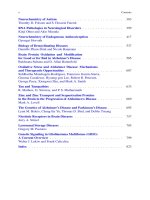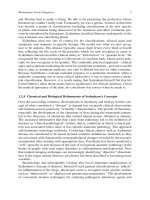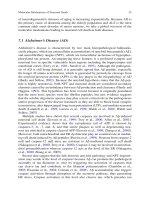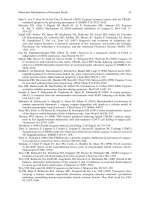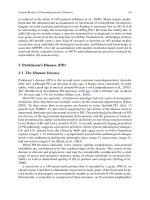Neurochemical Mechanisms in Disease P62 pdf
Bạn đang xem bản rút gọn của tài liệu. Xem và tải ngay bản đầy đủ của tài liệu tại đây (119.41 KB, 10 trang )
Brain Protein Oxidation in Alzheimer’s Disease 595
was recently confirmed by others (Choi et al., 2004). Taken together, these differ-
ent lines of evidence support a role for dysfunction of the ubiquitin–proteasome
pathway in the pathogenesis of AD. Others showed that diminished proteasome
function could l ead to neurodegeneration (Halliwell, 2002) and oxidative stress
(Ding et al., 2003). On the other hand, oxidative stress leads to proteasome dysfun-
tion (Halliwell, 2002, 2006), suggesting a vicious feedforward cycle of oxidative
stress, proteasome dysfunction, and neurodegeneration.
Neuropolypeptide h3 (NPH3), a phosphatidyloethanolamine-binding protein
[PEBP] or cholinergic neurostimulating peptide, may play an important role in reg-
ulating choline acetyl transferase (ChAT) and maintaining phospholipid asymmetry,
a process that is important to normal mitochondrial and plasma membrane function
(Castegna et al., 2004a; Mohmmad Abdul and Butterfield, 2005). Oxidation of this
protein could lead to impaired cholinergic properties, mitochondria function, and
apoptosis in AD.
β-actin (ACT) and dihydropyrimidinase-related protein 2 (DRP2) were found to
be downregulated and oxidatively modified in AD brain (Coleman and Flood, 1987;
Lubec et al., 1999; Castegna et al., 2002a,b, 2003). Alterations in the structure of
proteins induced due to oxidation could be one of the contributing factors involved
in the observed loss of interneuronal connections, neuronal repair, and shortened
dendritic lengths in AD brain (Coleman and Flood, 1987), conceivably leading to
memory impairment and synapse loss, clearly important for AD.
Another important protein that is found to have reduced expression and is also
oxidized and has reduced activity in AD brain is peptidyl-prolyl cis/trans isomerase
(Pin1). This protein is colocalized with phosphorylated tau (Holzer et al., 2002;Kurt
et al., 2003; Ramakrishnan et al., 2003; Sultana et al., 2006c, d). Pin1 is a chaperone
enzyme that recognizes phosphorylated Ser-Pro and phosphorylated Thr-Pro motifs
in proteins, and alters the conformation of proteins from cis to trans between a given
amino acid and a proline (Schutkowski et al., 1998). One of the target proteins of
Pin1 is a protein that removes phosphate moieties from tau (Shen et al., 1998).
Oxidative modification of Pin1 may lead to hyperphosphorylation of tau, and entry
into a cell cycle eventually leading to tangle formation and apoptosis (Nagy et al.,
1997; Zhou et al., 2000; Smith et al., 2004). In addition to a role of Pin1 in neu-
rofibrillary tangle formation, recent studies suggest that Pin1 plays a role in APP
processing, and therefore, in Aβ levels in brain (Pastorino et al., 2006). Thus, Pin1
is involved in two of the major pathological hallmarks of AD. Pin1 is oxidatively
modified and dysfunctional in mild cognitive impairment (MCI), a precursor condi-
tion to AD (Butterfield, 2006). Further studies are required to understand the role of
Pin1 in the disease progression.
Soluble N-ethylmaleimidesensitive factor (NSF) attachment protein (γ-SNAP)
is another protein found to be oxidatively modified in AD brain, and this protein is
important in vesicular transport for neurotransmitter release, hormone secretion, and
mitochondrial integrity. Hence, oxidation may lead to an altered neurotransmission
system and impaired learning and memory in AD (Masliah et al., 1994; Scheff and
Price, 2003; Sultana et al., 2006d).
596 R. Sultana and D.A. Butterfield
The pH of the cell is crucial for the normal functioning of the cells. Carbonic
anhydrase 2 (CA2) regulates cellular pH, CO
2
, and HCO
3
–
transport, and maintains
H
2
O and electrolyte balance (Sly and Hu, 1995) by reversible hydration of CO
2
in
normal cells. This protein has been reported to be oxidized in AD brain and also
showed a decrease in activity (Meier-Ruge et al., 1984; Poon et al., 2004; Sultana
et al., 2006d). Functionally inactive CA2 could induce changes in buffering systems
in the brain, which could consequently lead to protein aggregation. Protein aggre-
gation is more pronounced in AD brain, and, because cellular pH could be altered,
altered mitochondrial production of ATP could be affected.
The voltage-dependent anion channel (VDAC) is identified as one of the oxi-
dized proteins in AD brain (Sultana et al., 2006a,b). The oxidation of this protein
in AD suggests an alteration in the function of the mitochondrial permeability
transition pore (MPTP) leading to mitochondrial depolarization and altered sig-
nal transduction pathways, which could be crucial in synaptic transmission and
plasticity. Moreover, alterations in the MPTP could lead to apoptotic processes.
In addition, dysfunction of mitochondria recently has been reported to alter APP
metabolism, enhancing the intraneuronal accumulation of amyloid β-peptide and
enhancing neuronal vulnerability (Busciglio et al., 2002).
Overall, from the data presented above it is clear that oxidation of specific brain
proteins alters the structure and thereby function of the proteins. Such changes could
be important in AD pathology.
4 Is Protein Oxidation an Early or Late Event
in AD Pathogenesis?
In recent years, the clinical stages preceding AD presenting memory impairment
but without overt dementia have attained increased attention in the AD clinical and
research fields. Patients with MCI are subjects with memory or other cognitive com-
plaints but who do not fulfill the dementia criteria (Visser et al., 2001). Persons with
MCI represent a heterogeneous group of patients with several possible explanations
for the cognitive deficits. A high proportion of MCI patients are probably early
AD subjects, although other diagnoses are also included in this diagnostic entity.
Biochemical markers for AD should reflect the pathogenesis of the disorder.
Both in MCI and AD patients, mean plasma levels of nonenzymatic antioxi-
dants and activity of antioxidant enzymes appeared to be lower than in controls,
with no parallel induction of antioxidant enzymes (Keller et al., 2005). In order to
explain these results it has been suggested that the increased free radical production
in MCI might lead to a rapid consumption of plasma antioxidants without a simul-
taneous activation of new molecules of antioxidant enzymes. Individuals with MCI,
and subsequently with AD, are likely to have an inadequate antioxidant enzymatic
activity, unable to counteract the increased production of free radicals during the
pathogenesis of the disease.
Brain Protein Oxidation in Alzheimer’s Disease 597
Subjects with MCI have increased protein oxidation in hippocampus and IPL
(Butterfield et al., 2006a) and superior and medial temporal gyri (Keller et al.,
2005). Additionally, using redox proteomics we identified three specific proteins,
that is, enolase, glutamine synthase, and Pin1 as common targets of protein oxida-
tion between MCI and AD which suggests that protein oxidation of these selected
proteins could be important in initial events involved in AD pathogenesis (Fig. 5).
Furthermore, several gene mutations associated with AD have been observed in
subjects with MCI including mutations in apolipoprotein E, presenilin 1, and the
amyloid precursor protein (Traykov et al., 2002; Nacmias et al., 2004). Increased
levels of lipid peroxidation have been reported in the brain of persons with MCI
(Keller et al., 2005; Markesbery et al., 2005; Butterfield et al., 2006b). Thus,
increased levels of protein and lipid peroxidation could be implicated as early events
in AD pathophysiology and also suggest that pharmacological intervention to pre-
vent protein and lipid peroxidation at the MCI stage or earlier may be a promising
therapeutic strategy to delay or prevent progression to AD.
AD
gamma-Enolase
alpha-enolase
glutamine
Creatinine Kinase
Triose Phosphate Isomerase
Phosphoglycerate mutase 1
Ubiquitin carboxy-terminal
hydrolase L-1
Heat Shock Cognate 71
Dihydropyrimidinase-related
protein 2
Gamma-SNAP,
Carbonic anhydrase 2
MCI
synthetase
peptidyl-prolyl
cis/trans isomerase 1.
Pyruvate kinase M2
Fig. 5 Comparison between the MCI and AD brain to see the common targets of protein oxidation
Very recent studies reported increased oxidative damage in nuclear and mito-
condrial DNA in MCI, as indexed by increased levels of 8-hydroxyguanosine
(8-OHdG), 2,6-diamino-4-hydroxy-5-formamidopyrimidine (fapyguanine), 8-hyd-
roadenine, 4,6-diamino-5-formamidopyrimidine (fapyadenine), and 5-hydroxy-
cytosine (Wang et al., 2006). Due to the crucial role that DNA plays in cells,
high levels of oxidation, particularly early in the progression of AD, may result
in a decline of normal cell function through altered transcription, changes in pro-
tein expression, or cross-linking with proteins. Taken together, these results suggest
that oxidative damage is one of the factors involved in the pathogenesis of neu-
rodegeneration in AD and is not simply a late effect of the neurodegenerative
process.
598 R. Sultana and D.A. Butterfield
5 Conclusions
Protein oxidation may be an early event in AD pathogenesis as supported by the
data from the MCI brain. With exceptions related to oxidative signaling or other
beneficial processes, excessive oxidation of proteins has been reported to decrease
the functionality of most proteins, which suggests that protein oxidation is harmful
for cell survival. Further studies are in progress to understand the role of protein
oxidation and its abrogation in AD by using in vivo and in vitro models of AD
centered around Aβ(1-42) (Sultana et al., 2006a).
Acknowledgments This work was supported in part by NIH grants [AG-10836; AG-05119].
References
Akama KT, Van Eldik LJ (2000) Beta-amyloid stimulation of inducible nitric-oxide synthase in
astrocytes is interleukin-1beta- and tumor necrosis factor-alpha (TNFalpha)-dependent, and
involves a TNFalpha receptor-associated factor- and NFkappaB-inducing kinase-dependent
signaling mechanism. J Biol Chem 275:7918–7924
Akiyama H, Arai T, Kondo H, Tanno E, Haga C, Ikeda K (2000) Cell mediators of
inflammation in the Alzheimer disease brain. Alzheimer Dis Assoc Disord 14(Suppl 1):
S47–S53
Aksenova M, Butterfield DA, Zhang SX, Underwood M, Geddes JW (2002) Increased protein
oxidation and decreased creatine kinase BB expression and activity after spinal cord contusion
injury. J Neurotrauma 19:491–502
Alderton WK, Cooper CE, Knowles RG (2001) Nitric oxide synthases: structure, function and
inhibition. Biochem J 357:593–615
Arispe N, Rojas E, Pollard HB (1993) Alzheimer disease amyloid beta protein forms calcium
channels in bilayer membranes: blockade by tromethamine and aluminum. Proc Natl Acad Sci
U S A 90:567–571
Ashe KH (2005) Mechanisms of memory loss in Abeta and tau mouse models. Biochem Soc Trans
33:591–594
Atwood CS, Huang X, Khatri A, Scarpa RC, Kim YS, Moir RD, Tanzi RE, Roher AE, Bush
AI (2000) Copper catalyzed oxidation of Alzheimer Abeta. Cell Mol Biol (Noisy-le-grand)
46:777–783
Aulak KS, Koeck T, Crabb JW, Stuehr DJ (2004) Dynamics of protein nitration in cells and
mitochondria. Am J Physiol Heart Circ Physiol 286:H30–H38
Beal MF (1998) Mitochondrial dysfunction in neurodegenerative diseases. Biochim Biophys Acta
1366:211–223
Beckman JS (1996) Oxidative damage and tyrosine nitration from peroxynitrite. Chem Res Toxicol
9:836–844
Beckman JS, Estevez AG, Crow JP, Barbeito L (2001) Superoxide dismutase and the death of
motoneurons in ALS. Trends Neurosci 24:S15–S20
Beckman JS, Koppenol WH (1996) Nitric oxide, superoxide, and peroxynitrite: the good, the bad,
and ugly. Am J Physiol 271:C1424–C1437
Behl C (1999) Vitamin E and other antioxidants in neuroprotection. Int J Vitam Nutr Res 69:
213–219
Berlett BS, Stadtman ER (1997) Protein oxidation in aging, disease, and oxidative stress. J Biol
Chem 272:20313–20316
Blanc EM, Kelly JF, Mark RJ, Waeg G, Mattson MP (1997) 4-Hydroxynonenal, an aldehydic
product of lipid peroxidation, impairs signal transduction associated with muscarinic acetyl-
choline and metabotropic glutamate receptors: possible action on G alpha(q/11). J Neurochem
69:570–580
Brain Protein Oxidation in Alzheimer’s Disease 599
Boyd-Kimball D, Castegna A, Sultana R, Poon HF, Petroze R, Lynn BC, Klein JB, Butterfield
DA (2005a) Proteomic identification of proteins oxidized by Abeta(1-42) in synaptosomes:
implications for Alzheimer’s disease. Brain Res 1044:206–215
Boyd-Kimball D, Sultana R, Mohmmad-Abdul H, Butterfield DA (2004) Rodent Abeta(1-42)
exhibits oxidative stress properties similar to those of human Abeta(1-42): Implications for
proposed mechanisms of toxicity. J Alzheimers Dis 6:515–525
Boyd-Kimball D, Sultana R, Poon HF, Lynn BC, Casamenti F, Pepeu G, Klein JB, Butterfield DA
(2005b) Proteomic identification of proteins specifically oxidized by intracerebral injection of
amyloid beta-peptide (1-42) into rat brain: implications for Alzheimer’s disease. Neuroscience
132:313–324
Brennan ML, Wu W, Fu X, Shen Z, Song W, Frost H, Vadseth C, Narine L, Lenkiewicz E, Borchers
MT, Lusis AJ, Lee JJ, Lee NA, Abu-Soud HM, Ischiropoulos H, Hazen SL (2002) A tale
of two controversies: defining both the role of peroxidases in nitrotyrosine formation in vivo
using eosinophil peroxidase and myeloperoxidase-deficient mice, and the nature of peroxidase-
generated reactive nitrogen species. J Biol Chem 277:17415–17427
Busciglio J, Pelsman A, Wong C, Pigino G, Yuan M, Mori H, Yankner BA (2002) Altered
metabolism of the amyloid beta precursor protein is associated with mitochondrial dysfunction
in Down’s syndrome. Neuron 33:677–688
Bush AI (2000) Metals and neuroscience. Curr Opin Chem Biol 4:184–191
Butterfield DA (2002) Amyloid beta-peptide (1-42)-induced oxidative stress and neurotoxicity:
implications for neurodegeneration in Alzheimer’s disease brain. A review. Free Radic Res
36:1307–1313
Butterfield DA (2004) Proteomics: a new approach to investigate oxidative stress in Alzheimer’s
disease brain. Brain Res 1000:1–7
Butterfield DA (2006) Oxidative stress in neurodegenerative disorders. Antioxidant Redox Signal
8:1971–1974
Butterfield DA, Boyd-Kimball D (2005) The critical role of methionine 35 in Alzheimer’s amy-
loid beta-peptide (1-42)-induced oxidative stress and neurotoxicity. Biochim Biophys Acta
1703:149–156
Butterfield DA, Drake J, Pocernich C, Castegna A (2001) Evidence of oxidative damage in
Alzheimer’s disease brain: central role for amyloid beta-peptide. Trends Mol Med 7:548–554
Butterfield DA, Hensley K, Harris M, Mattson M, Carney J (1994) beta-Amyloid peptide
free radical fragments initiate synaptosomal lipoperoxidation in a sequence-specific fashion:
implications to Alzheimer’s disease. Biochem Biophys Res Commun 200:710–715
Butterfield DA, Hensley K, Cole P, Subramaniam R, Aksenov M, Aksenova M, Bummer PM,
Haley BE, Carney JM (1997) Oxidatively-induced structural alteration of glutamine synthetase
assessed by analysis of spin labeled incorporation kinetics: relevance to Alzheimer’s disease. J
Neurochem 68:2451–2457
Butterfield DA, Kanski J (2002) Methionine residue 35 is critical for the oxidative stress and
neurotoxic properties of Alzheimer’s amyloid beta-peptide 1-42. Peptides 23:1299–1309
Butterfield DA, Lauderback CM (2002) Lipid peroxidation and protein oxidation in Alzheimer’s
disease brain: potential causes and consequences involving amyloid beta-peptide-associated
free radical oxidative stress. Free Radic Biol Med 32:1050–1060
Butterfield DA, Poon HF, St Clair D, Keller JN, Pierce WM, Klein JB, Markesbery WR (2006a)
Redox proteomics identification of oxidatively modified hippocampal proteins in mild cog-
nitive impairment: Insights into the development of Alzheimer’s disease. Neurobiol Dis
22(2):223–232
Butterfield DA, Reed T, Perluigi M, De Marco C, Coccia R, Cini C, Sultana R (2006b) Elevated
protein-bound levels of the lipid peroxidation product, 4-hydroxy-2-nonenal, in brain from
persons with mild cognitive impairment. Neurosci Lett 397:170–173
Butterfield DA, Stadtman ER (1997) Protein oxidation processes in aging brain. Adv Cell Aging
Gerontol vol. 2:pp. 161–191
Casserly I, Topol E (2004) Convergence of atherosclerosis and Alzheimer’s disease: inflammation,
cholesterol, and misfolded proteins. Lancet 363:1139–1146
600 R. Sultana and D.A. Butterfield
Castegna A, Aksenov M, Aksenova M, Thongboonkerd V, Klein JB, Pierce WM, Booze R,
Markesbery WR, Butterfield DA (2002a) Proteomic identification of oxidatively modified pro-
teins in Alzheimer’s disease brain. Part I: creatine kinase BB, glutamine synthase, and ubiquitin
carboxy-terminal hydrolase L-1. Free Radic Biol Med 33:562–571
Castegna A, Aksenov M, Thongboonkerd V, Klein JB, Pierce WM, Booze R, Markesbery
WR, Butterfield DA (2002b) Proteomic identification of oxidatively modified proteins in
Alzheimer’s disease brain. Part II: dihydropyrimidinase-related protein 2, alpha-enolase and
heat shock cognate 71. J Neurochem 82:1524–1532
Castegna A, Lauderback CM, Mohmmad-Abdul H, Butterfield DA (2004a) Modulation of
phospholipid asymmetry in synaptosomal membranes by the lipid peroxidation products,
4-hydroxynonenal and acrolein: implications for Alzheimer’s disease. Brain Res 1004:193–197
Castegna A, Thongboonkerd V, Klein JB, Lynn B, Markesbery WR, Butterfield DA (2003)
Proteomic identification of nitrated proteins in Alzheimer’s disease brain. J Neurochem
85:1394–1401
Castegna A, Thongboonkerd V, Klein J, Lynn BC, Wang YL, Osaka H, Wada K, Butterfield DA
(2004b) Proteomic analysis of brain proteins in the gracile axonal dystrophy (gad) mouse, a
syndrome that emanates from dysfunctional ubiquitin carboxyl-terminal hydrolase L-1, reveals
oxidation of key proteins. J Neurochem 88:1540–1546
Cherny RA, Barnham KJ, Lynch T, Volitakis I, Li QX, McLean CA, Multhaup G, Beyreuther K,
Tanzi RE, Masters CL, Bush AI (2000) Chelation and intercalation: complementary properties
in a compound for the treatment of Alzheimer’s disease. J Struct Biol 130:209–216
Choi J, Levey AI, Weintraub ST, Rees HD, Gearing M, Chin LS, Li L (2004) Oxidative mod-
ifications and down-regulation of ubiquitin carboxyl-terminal hydrolase L1 associated with
idiopathic Parkinson’s and Alzheimer’s diseases. J Biol Chem 279:13256–13264
Choi J, Malakowsky CA, Talent JM, Conrad CC, Gracy RW (2002) Identification of oxi-
dized plasma proteins in Alzheimer’s disease. Biochem Biophys Res Commun 293:
1566–1570
Coleman PD, Flood DG (1987) Neuron numbers and dendritic extent in normal aging and
Alzheimer’s disease. Neurobiol Aging 8:521–545
Curtain CC, Ali F, Volitakis I, Cherny RA, Norton RS, Beyreuther K, Barrow CJ, Masters CL, Bush
AI, Barnham KJ (2001) Alzheimer’s disease amyloid-beta binds copper and zinc to generate
an allosterically ordered membrane-penetrating structure containing superoxide dismutase-like
subunits. J Biol Chem 276:20466–20473
Dalle-Donne I, Giustarini D, Colombo R, Rossi R, Milzani A (2003a) Protein carbonylation in
human diseases. Trends Mol Med 9:169–176
Dalle-Donne I, Rossi R, Giustarini D, Milzani A, Colombo R (2003b) Protein carbonyl groups as
biomarkers of oxidative stress. Clin Chim Acta 329:23–38
Dalle-Donne I, Scaloni A, Butterfield DA (2006) Redox proteomics: from protein modifications to
cellualr dysfunction and disease. New York, NY, Wiley
Dalle-Donne I, Scaloni A, Giustarini D, Cavarra E, Tell G, Lungarella G, Colombo R, Rossi R,
Milzani A (2005) Proteins as biomarkers of oxidative/nitrosative stress in diseases: the
contribution of redox proteomics. Mass Spectrom Rev 24:55–99
Dean RT, Fu S, Stocker R, Davies MJ (1997) Biochemistry and pathology of radical-mediated
protein oxidation. Biochem J 324(Pt 1):1–18
Ding Q, Dimayuga E, Keller JN (2006) Proteasome regulation of oxidative stress in aging and
age-related diseases of the CNS. Antioxid Redox Signal 8:163–172
Ding Q, Reinacker K, Dimayuga E, Nukala V, Drake J, Butterfield DA, Dunn JC, Martin S, Bruce-
Keller AJ, Keller JN (2003) Role of the proteasome in protein oxidation and neural viability
following low-level oxidative stress. FEBS Lett 546:228–232
Drake J, Link CD, Butterfield DA (2003) Oxidative stress precedes fibrillar deposition of
Alzheimer’s disease amyloid beta-peptide (1-42) in a transgenic Caenorhabditis elegans model.
Neurobiol Aging 24:415–420
Engstrom I, Ronquist G, Pettersson L, Waldenstrom A (1995) Alzheimer amyloid beta-peptides
exhibit ionophore-like properties in human erythrocytes. Eur J Clin Invest 25:471–476
Brain Protein Oxidation in Alzheimer’s Disease 601
Etcheberrigaray R, Ito E, Kim CS, Alkon DL (1994) Soluble beta-amyloid induction of
Alzheimer’s phenotype for human fibroblast K+ channels. Science 264:276–279
Evans DA, Funkenstein HH, Albert MS, Scherr PA, Cook NR, Chown MJ, Hebert LE, Hennekens
CH, Taylor JO (1989) Prevalence of Alzheimer’s disease in a community population of older
persons. Higher than previously reported. J Am Med Assoc 262:2551–2556
Fiala M, Zhang L, Gan X, Sherry B, Taub D, Graves MC, Hama S, Way D, Weinand M, Witte M,
Lorton D, Kuo YM, Roher AE (1998) Amyloid-beta induces chemokine secretion
and monocyte migration across a human blood–brain barrier model. Mol Med 4:
480–489
Gabbita SP, Aksenov MY, Lovell MA, Markesbery WR (1999) Decrease in peptide methionine
sulfoxide reductase in Alzheimer’s disease brain. J Neurochem 73:1660–1666
Geddes JW, Pang Z, Wiley DH (1996) Hippocampal damage and cytoskeletal disruption resulting
from impaired energy metabolism. Implications for Alzheimer disease. Mol Chem Neuropathol
28:65–74
Gow AJ, Duran D, Malcolm S, Ischiropoulos H (1996) Effects of peroxynitrite-induced protein
modifications on tyrosine phosphorylation and degradation. FEBS Lett 385:63–66
Grune T, Merker K, Sandig G, Davies KJ (2003) Selective degradation of oxidatively modified
protein substrates by the proteasome. Biochem Biophys Res Commun 305:709–718
Halliwell B (2002) Hypothesis: proteasomal dysfunction: a primary event in neurogeneration that
leads to nitrative and oxidative stress and subsequent cell death. Ann N Y Acad Sci 962:
182–194
Halliwell B (2006) Proteasomal Dysfunction: A Common Feature of Neurodegenerative Diseases?
Implications for the Environmental Origins of Neurodegeneration. Antioxid Redox Signal
8(11–12):2007–2019
Hara MR, Cascio MB, Sawa A (2006) GAPDH as a sensor of NO stress. Biochim Biophys Acta
1762:502–509
Hardy J, Selkoe DJ (2002) The amyloid hypothesis of Alzheimer’s disease: progress and problems
on the road to therapeutics. Science 297:353–356
Healy DG, Abou-Sleiman PM, Wood NW (2004) Genetic causes of Parkinson’s disease: UCHL-1.
Cell Tissue Res 318:189–194
Hensley K, Hall N, Subramaniam R, Cole P, Harris M, Aksenov M, Aksenova M, Gabbita SP,
Wu JF, Carney JM, et al. (1995) Brain regional correspondence between Alzheimer’s disease
histopathology and biomarkers of protein oxidation. J Neurochem 65:2146–2156
Hensley K, Maidt ML, Yu Z, Sang H, Markesbery WR, Floyd RA (1998) Electrochemical anal-
ysis of protein nitrotyrosine and dityrosine in the Alzheimer brain indicates region-specific
accumulation. J Neurosci 18:8126–8132
Hesse L, Beher D, Masters CL, Multhaup G (1994) The beta A4 amyloid precursor protein binding
to copper. FEBS Lett 349:109–116
Holzer M, Gartner U, Stobe A, Hartig W, Gruschka H, Bruckner MK, Arendt T (2002)
Inverse association of Pin1 and tau accumulation in Alzheimer’s disease hippocampus. Acta
Neuropathol (Berl) 104:471–481
Horiguchi T, Uryu K, Giasson BI, Ischiropoulos H, LightFoot R, Bellmann C, Richter-Landsberg
C, Lee VM, Trojanowski JQ (2003) Nitration of tau protein is linked to neurodegeneration in
tauopathies. Am J Pathol 163:1021–1031
Huang X, Atwood CS, Hartshorn MA, Multhaup G, Goldstein LE, Scarpa RC, Cuajungco MP,
Gray DN, Lim J, Moir RD, Tanzi RE, Bush AI (1999) The A beta peptide of Alzheimer’s
disease directly produces hydrogen peroxide through metal ion reduction. Biochemistry
38:7609–7616
Hyun DH, Lee MH, Halliwell B, Jenner P (2002) Proteasomal dysfunction induced by 4-
hydroxy-2,3-trans-nonenal, an end-product of lipid peroxidation: a mechanism contributing to
neurodegeneration? J Neurochem 83:360–370
Iadecola C (2003) Cerebrovascular effects of amyloid-beta peptides: mechanisms and implications
for Alzheimer’s dementia. Cell Mol Neurobiol 23:681–689
602 R. Sultana and D.A. Butterfield
Ignarro LJ, Byrns RE, Wood KS (1987) Endothelium-dependent modulation of cGMP levels and
intrinsic smooth muscle tone in isolated bovine intrapulmonary artery and vein. Circ Res
60:82–92
Irie Y, Saeki M, Kamisaki Y, Martin E, Murad F (2003) Histone H1.2 is a substrate for denitrase,
an activity that reduces nitrotyrosine immunoreactivity in proteins. Proc Natl Acad Sci U S A
100:5634–5639
Ischiropoulos H (1998) Biological tyrosine nitration: a pathophysiological function of nitric oxide
and reactive oxygen species. Arch Biochem Biophys 356:1–11
Kalaria RN (2000) The role of cerebral ischemia in Alzheimer’s disease. Neurobiol Aging 21:
321–330
Kamisaki Y, Wada K, Bian K, Balabanli B, Davis K, Martin E, Behbod F, Lee YC, Murad F (1998)
An activity in rat tissues that modifies nitrotyrosine-containing proteins. Proc Natl Acad Sci U
S A 95:11584–11589
Kardos J, Kovacs I, Hajos F, Kalman M, Simonyi M (1989) Nerve endings from rat brain tissue
release copper upon depolarization. A possible role in regulating neuronal excitability. Neurosci
Lett 103:139–144
Keller JN, Mark RJ, Bruce AJ, Blanc E, Rothstein JD, Uchida K, Waeg G, Mattson MP (1997)
4-Hydroxynonenal, an aldehydic product of membrane lipid peroxidation, impairs glutamate
transport and mitochondrial function in synaptosomes. Neuroscience 80:685–696
Keller JN, Schmitt FA, Scheff SW, Ding Q, Chen Q, Butterfield DA, Markesbery WR (2005)
Evidence of increased oxidative damage in subjects with mild cognitive impairment. Neurology
64:1152–1156
Klein WL, Stine WB Jr., Teplow DB (2004) Small assemblies of unmodified amyloid beta-protein
are the proximate neurotoxin in Alzheimer’s disease. Neurobiol Aging 25:569–580
Koeck T, Levison B, Hazen SL, Crabb JW, Stuehr DJ, Aulak KS (2004) Tyrosine nitration impairs
mammalian aldolase A activity. Mol Cell Proteomics 3:548–557
Kurt MA, Davies DC, Kidd M, Duff K, Howlett DR (2003) Hyperphosphorylated tau and paired
helical filament-like structures in the brains of mice carrying mutant amyloid precursor protein
and mutant presenilin-1 transgenes. Neurobiol Dis 14:89–97
Lafon-Cazal M, Culcasi M, Gaven F, Pietri S, Bockaert J (1993) Nitric oxide, superoxide and
peroxynitrite: putative mediators of NMDA-induced cell death in cerebellar granule cells.
Neuropharmacology 32:1259–1266
Levine RL, Wehr N, Williams JA, Stadtman ER, Shacter E (2000) Determination of carbonyl
groups in oxidized proteins. Methods Mol Biol 99:15–24
Lovell MA, Markesbery WR (2001) Ratio of 8-hydroxyguanine in intact DNA to free 8-
hydroxyguanine is increased in Alzheimer disease ventricular cerebrospinal fluid. Arch Neurol
58:392–396
Lubec G, Nonaka M, Krapfenbauer K, Gratzer M, Cairns N, Fountoulakis M (1999) Expression of
the dihydropyrimidinase related protein 2 (DRP-2) in Down syndrome and Alzheimer’s disease
brain is downregulated at the mRNA and dysregulated at the protein level. J Neural Transm
Suppl 57:161–177
Luchsinger JA, Reitz C, Honig LS, Tang MX, Shea S, Mayeux R (2005) Aggregation of vascular
risk factors and risk of incident Alzheimer disease. Neurology 65:545–551
Mark RJ, Lovell MA, Markesbery WR, Uchida K, Mattson MP (1997) A role for 4-
hydroxynonenal, an aldehydic product of lipid peroxidation, in disruption of ion homeostasis
and neuronal death induced by amyloid beta-peptide. J Neurochem 68:255–264
Markesbery WR (1997) Oxidative stress hypothesis in Alzheimer’s disease. Free Radic Biol Med
23:134–147
Markesbery WR, Kryscio RJ, Lovell MA, Morrow JD (2005) Lipid peroxidation is an early event
in the brain in amnestic mild cognitive impairment. Ann Neurol 58:730–735
Masliah E, Mallory M, Hansen L, DeTeresa R, Alford M, Terry R (1994) Synaptic and neuritic
alterations during the progression of Alzheimer’s disease. Neurosci Lett 174:67–72
Mattson MP, Parin J, Begley JG (1998) Amyloid beta-peptide induces apoptosis-related events in
synapses and dendrites. Brain Res 807:167–176
Brain Protein Oxidation in Alzheimer’s Disease 603
McGeer EG, McGeer PL (2003) Inflammatory processes in Alzheimer’s disease. Prog
Neuropsychopharmacol Biol Psychiatry 27:741–749
Meda L, Cassatella MA, Szendrei GI, Otvos L Jr., Baron P, Villalba M, Ferrari D, Rossi F (1995)
Activation of microglial cells by beta-amyloid protein and interferon-gamma. Nature 374:
647–650
Meier-Ruge W, Iwangoff P, Reichlmeier K (1984) Neurochemical enzyme changes in Alzheimer’s
and Pick’s disease. Arch Gerontol Geriatr 3:161–165
Messier C, Gagnon M (1996) Glucose regulation and cognitive functions: relation to Alzheimer’s
disease and diabetes. Behav Brain Res 75:1–11
Messier C, Teutenberg K (2005) The role of insulin, insulin growth factor, and insulin-degrading
enzyme in brain aging and Alzheimer’s disease. Neural Plast 12:311–328
Mohmmad Abdul H, Butterfield DA (2005) Protection against amyloid beta-peptide (1-42)-
induced loss of phospholipid asymmetry in synaptosomal membranes by tricyclodecan-
9-xanthogenate (D609) and ferulic acid ethyl ester: implications for Alzheimer’s disease.
Biochim Biophys Acta 1741:140–148
Mohmmad Abdul H, Wenk GL, Gramling M, Hauss-Wegrzyniak B, Butterfield DA (2004)
APP and PS-1 mutations induce brain oxidative stress independent of dietary cholesterol:
implications for Alzheimer’s disease. Neurosci Lett 368:148–150
Moskovitz J, Yim MB, Chock PB (2002) Free radicals and disease. Arch Biochem Biophys
397:354–359
Mucke L, Masliah E, Johnson WB, Ruppe MD, Alford M, Rockenstein EM, Forss-Petter S,
Pietropaolo M, Mallory M, Abraham CR (1994) Synaptotrophic effects of human amyloid
beta protein precursors in the cortex of transgenic mice. Brain Res 666:151–167
Nacmias B, Piccini C, Bagnoli S, Tedde A, Cellini E, Bracco L, Sorbi S (2004) Brain-derived neu-
rotrophic factor, apolipoprotein E genetic variants and cognitive performance in Alzheimer’s
disease. Neurosci Lett 367:379–383
Nagy Z, Esiri MM, Cato AM, Smith AD (1997) Cell cycle markers in the hippocampus in
Alzheimer’s disease. Acta Neuropathol (Berl) 94:6–15
Okada K, Wangpoengtrakul C, Osawa T, Toyokuni S, Tanaka K, Uchida K (1999) 4-Hydroxy-2-
nonenal-mediated impairment of intracellular proteolysis during oxidative stress. Identification
of proteasomes as target molecules. J Biol Chem 274:23787–23793
PastorinoL,SunA,LuPJ,ZhouXZ,BalastikM,FinnG,WulfG,LimJ,LiSH,LiX,XiaW,
Nicholson LK, Lu KP (2006) The prolyl isomerase Pin1 regulates amyloid precursor protein
processing and amyloid-beta production. Nature 440:528–534
Planel E, Miyasaka T, Launey T, Chui DH, Tanemura K, Sato S, Murayama O, Ishiguro K,
Tatebayashi Y, Takashima A (2004) Alterations in glucose metabolism induce hypothermia
leading to tau hyperphosphorylation through differential inhibition of kinase and phosphatase
activities: implications for Alzheimer’s disease. J Neurosci 24:2401–2411
Poon HF, Joshi G, Sultana R, Farr SA, Banks WA, Morley JE, Calabrese V, Butterfield DA (2004)
Antisense directed at the Abeta region of APP decreases brain oxidative markers in aged
senescence accelerated mice. Brain Res 1018:86–96
Radi R, Denicola A, Freeman BA (1999) Peroxynitrite reactions with carbon dioxide-bicarbonate.
Methods Enzymol 301:353–367
Ramakrishnan P, Dickson DW, Davies P (2003) Pin1 colocalization with phosphorylated tau in
Alzheimer’s disease and other tauopathies. Neurobiol Dis 14:251–264
Rapoport SI (1999) In vivo PET imaging and postmortem studies suggest potentially reversible
and irreversible stages of brain metabolic failure in Alzheimer’s disease. Eur Arch Psychiatry
Clin Neurosci 249(Suppl 3):46–55
Scheff SW, Price DA (2003) Synaptic pathology in Alzheimer’s disease: a review of ultrastructural
studies. Neurobiol Aging 24:1029–1046
Schopfer FJ, Baker PR, Freeman BA (2003) NO-dependent protein nitration: a cell signaling event
or an oxidative inflammatory response? Trends Biochem Sci 28:646–654
604 R. Sultana and D.A. Butterfield
Schutkowski M, Bernhardt A, Zhou XZ, Shen M, Reimer U, Rahfeld JU, Lu KP, Fischer G (1998)
Role of phosphorylation in determining the backbone dynamics of the serine/threonine-proline
motif and Pin1 substrate recognition. Biochemistry 37:5566–5575
Selkoe DJ (2001) Alzheimer’s disease results from the cerebral accumulation and cytotoxicity of
amyloid beta-protein. J Alzheimers Dis 3:75–80
Shen M, Stukenberg PT, Kirschner MW, Lu KP (1998) The essential mitotic peptidyl-
prolyl isomerase Pin1 binds and regulates mitosis-specific phosphoproteins. Genes Dev 12:
706–720
Shringarpure R, Grune T, Davies KJ (2001) Protein oxidation and 20S proteasome-dependent
proteolysis in mammalian cells. Cell Mol Life Sci 58:1442–1450
Sly WS, Hu PY (1995) Human carbonic anhydrases and carbonic anhydrase deficiencies. Annu
Rev Biochem 64:375–401
Smith PD, O’Hare MJ, Park DS (2004) Emerging pathogenic role for cyclin dependent kinases in
neurodegeneration. Cell Cycle 3:289–291
Smith MA, Richey Harris PL, Sayre LM, Beckman JS, Perry G (1997) Widespread peroxynitrite-
mediated damage in Alzheimer’s disease. J Neurosci 17:2653–2657
Stadtman ER, Levine RL (2003) Free radical-mediated oxidation of free amino acids and amino
acid residues in proteins. Amino Acids 25:207–218
Stuehr DJ (1999) Mammalian nitric oxide synthases. Biochim Biophys Acta 1411:217–230
Sultana R, Boyd-Kimball D, Poon HF, Cai J, Pierce WM, Klein JB, Markesbery WR, Zhou
XZ, Lu KP, Butterfield DA (2006c) Oxidative modification and down-regulation of Pin1
in Alzheimer’s disease hippocampus: A redox proteomics analysis. Neurobiol Aging 27(7):
918–925
Sultana R, Boyd-Kimball D, Poon HF, Cai J, Pierce WM, Klein JB, Merchant M, Markesbery WR,
Butterfield DA (2006d) Redox proteomics identification of oxidized proteins in Alzheimer’s
disease hippocampus and cerebellum: An approach to understand pathological and biochemical
alterations in AD. Neurobiol Aging 27(11):1564–1576
Sultana R, Perluigi M, Butterfield DA (2006a) Redox proteomics identification of oxidatively mod-
ified proteins in Alzheimer’s disease brain and in vivo and in vitro models of AD centered
around Abeta(1-42). J Chromatogr B Analyt Technol Biomed Life Sci 833:3–11
Sultana R, Poon HF, Cai J, Pierce WM, Merchant M, Klein JB, Markesbery WR, Butterfield
DA (2006b) Identification of nitrated proteins in Alzheimer’s disease brain using a redox
proteomics approach. Neurobiol Dis 22:76–87
Tohgi H, Abe T, Yamazaki K, Murata T, Ishizaki E, Isobe C (1999) Alterations of 3-nitrotyrosine
concentration in the cerebrospinal fluid during aging and in patients with Alzheimer’s disease.
Neurosci Lett 269:52–54
Traykov L, Rigaud AS, Baudic S, Smagghe A, Boller F, Forette F (2002) Apolipoprotein E
epsilon 4 a llele frequency in demented and cognitively impaired patients with and without
cerebrovascular disease. J Neurol Sci 203–204:177–181
Vanhanen M, Soininen H (1998) Glucose intolerance, cognitive impairment and Alzheimer’s
disease. Curr Opin Neurol 11:673–677
Varadarajan S, Kanski J, Aksenova M, Lauderback C, Butterfield DA (2001) Different mechanisms
of oxidative stress and neurotoxicity for Alzheimer’s A beta(1–42) and A beta(25–35). J Am
Chem Soc 123:5625–5631
Varadarajan S, Yatin S, Aksenova M, Butterfield DA (2000) Review: Alzheimer’s amyloid beta-
peptide-associated free radical oxidative stress and neurotoxicity. J Struct Biol 130:184–208
Verdier Y, Penke B (2004) Binding sites of amyloid beta-peptide in cell plasma membrane and
implications for Alzheimer’s disease. Curr Protein Pept Sci 5:19–31
Visser PJ, Verhey FR, Ponds RW, Jolles J (2001) Diagnosis of preclinical Alzheimer’s disease in a
clinical setting. Int Psychogeriatr 13:411–423
Walsh DM, Klyubin I, Shankar GM, Townsend M, Fadeeva JV, Betts V, Podlisny MB, Cleary JP,
Ashe KH, Rowan MJ, Selkoe DJ (2005) The role of cell-derived oligomers of Abeta
in Alzheimer’s disease and avenues for therapeutic intervention. Biochem Soc Trans 33:
1087–1090


